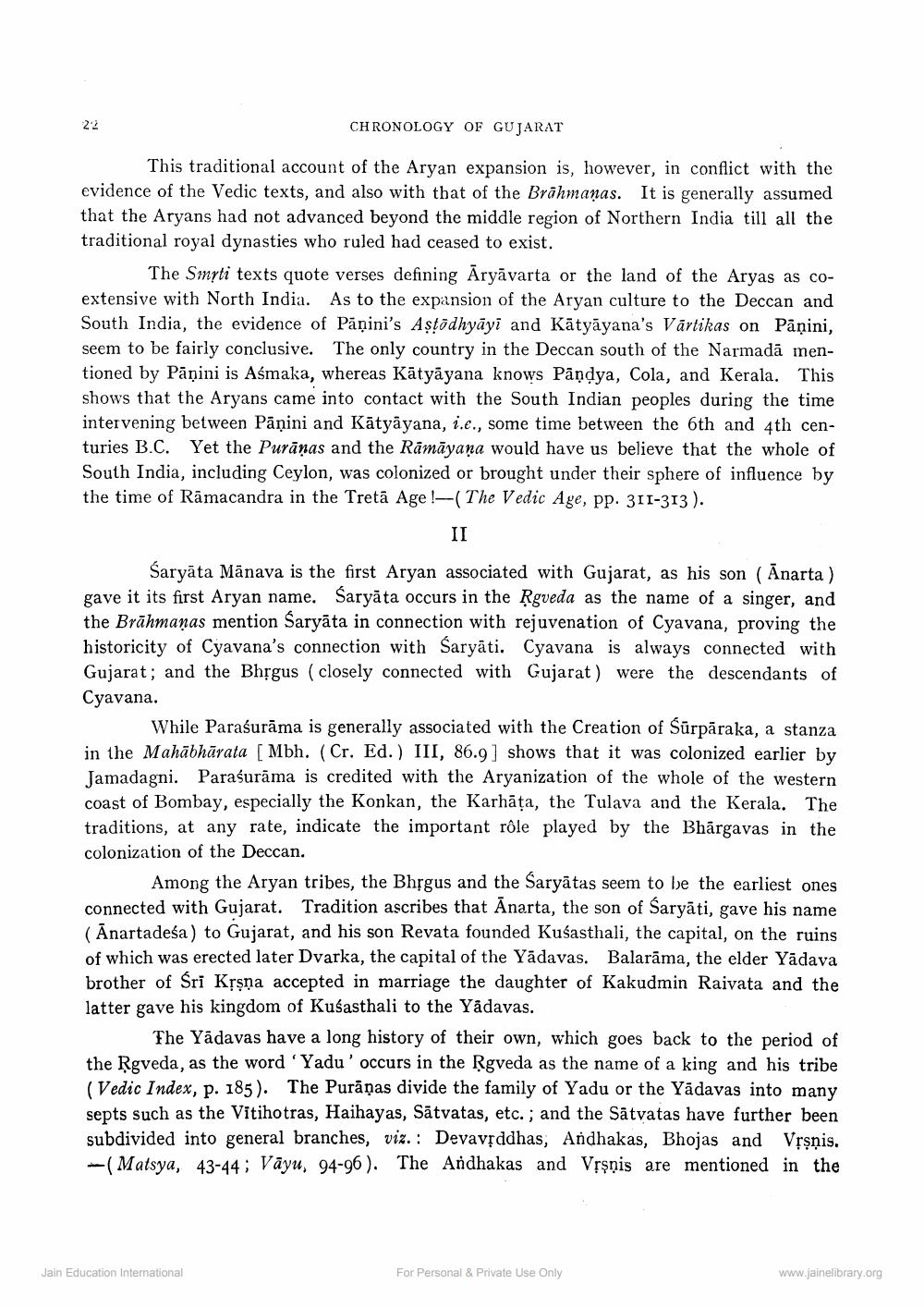________________
22
CHRONOLOGY OF GUJARAT
This traditional account of the Aryan expansion is, however, in conflict with the evidence of the Vedic texts, and also with that of the Brāhmaṇas. It is generally assumed that the Aryans had not advanced beyond the middle region of Northern India till all the traditional royal dynasties who ruled had ceased to exist.
The Smyti texts quote verses defining Āryāvarta or the land of the Aryas as coextensive with North India. As to the expansion of the Aryan culture to the Deccan and South India, the evidence of Pāṇini's Astödhyāyī and Kātyāyana's Vārtikas on Pāṇini, seem to be fairly conclusive. The only country in the Deccan south of the Narmadā mentioned by Pāṇini is Aśmaka, whereas Kātyāyana knows Pāņdya, Cola, and Kerala. This shows that the Aryans came into contact with the South Indian peoples during the time intervening between Pāņini and Kätyāyana, i.e., some time between the 6th and 4th centuries B.C. Yet the Purānas and the Rāmāyaṇa would have us believe that the whole of South India, including Ceylon, was colonized or brought under their sphere of influence by the time of Rāmacandra in the Tretā Age !-(The Vedic Age, pp. 311-313).
II
Śaryāta Mānava is the first Aryan associated with Gujarat, as his son (Ānarta) gave it its first Aryan name. Saryāta occurs in the Rgveda as the name of a singer, and the Brāhmaṇas mention Saryāta in connection with rejuvenation of Cyavana, proving the historicity of Cyavana's connection with Śaryāti. Cyavana is always connected with Gujarat; and the Bhrgus (closely connected with Gujarat) were the descendants of Cyavana.
While Paraśurāma is generally associated with the Creation of Sūrpāraka, a stanza in the Mahābhārata (Mbh. (Cr. Ed.) III, 86.9 ] shows that it was colonized earlier by Jamadagni. Parasurama is credited with the Aryanization of the whole of the western coast of Bombay, especially the Konkan, the Karhāța, the Tulava and the Kerala. The traditions, at any rate, indicate the important rôle played by the Bhargavas in the colonization of the Deccan.
Among the Aryan tribes, the Bhrgus and the Saryātas seem to be the earliest ones connected with Gujarat. Tradition ascribes that Anarta, the son of Saryāti, gave his name ( Ānartadeśa) to Gujarat, and his son Revata founded Kuśasthali, the capital, on the ruins of which was erected later Dvarka, the capital of the Yādavas. Balarama, the elder Yādava brother of Sri Krşņa accepted in marriage the daughter of Kakudmin Raivata and the latter gave his kingdom of Kuśasthali to the Yådavas.
The Yādavas have a long history of their own, which goes back to the period of the Rgveda, as the word 'Yadu' occurs in the Rgveda as the name of a king and his tribe (Vedic Index, p. 185). The Purāṇas divide the family of Yadu or the Yādavas into many septs such as the Vitihotras, Haihayas, Sātvatas, etc.; and the Sātvatas have further been subdivided into general branches, viz. : Devavěddhas, Andhakas, Bhojas and Vșşņis. -(Matsya, 43-44; Vāyu, 94-96). The Andhakas and Vrşnis are mentioned in the
Jain Education Interational
For Personal & Private Use Only
www.jainelibrary.org




